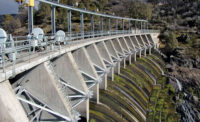Thanks to an agreement signed earlier this month, the $100-million demolition of a century-old timber-crib dam near Missoula, Mont., is expected to begin late next year. The hydroelectric Milltown Dam, located at the confluence of the Clark Fork and Blackfoot rivers, has blocked passage of endangered bull trout from the rivers� upper reaches, while locking in more than 2.5 million cu yd of sediment that has washed downstream from copper mining activities 100 miles away in Butte and Anaconda. The dam is part of a 120-mile-long Superfund site along the Clark Fork.
 |
| Century old hydro unit blocks 2.5 million cu yd of mine waste full of heavy metals. (Photo courtesy of Envirocon Inc.) |
In the early 1980s health officials discovered a spreading plume of arsenic, originating from the reservoir behind the dam, migrating into the area�s ground water and poisoning drinking wells. In 1996, a large ice floe on the Blackfoot River scoured into the sediment, sending the toxic metals downstream and killing fish. In January 2003, the Environmental Protection Agency, with support from the state, agreed to remove the dam (ENR 2/3/03 p. 14).
Under an agreement between EPA, Los Angeles-based Atlantic Richfield Co. and NorthWestern Corp., Sioux Falls, S.D. (owner of the five-unit, 3.2-MW powerplant), Arco will pay most of the bill, with NorthWestern chipping in $11.4 million, and the state�s natural resource damage restoration fund adding another $7.6 million. After a 30-day public comment period a judge will decide whether to approve the consent decree.
�We�re thrilled,� says Tracy Stone-Manning, head of the Clark Fork Coalition which has lobbied for 20 years to have the dam removed. John Wardell, EPA�s Region 8-Montana Office director, says he also is �very pleased with it.� In fact, apart from a few pike fishermen who frequent the reservoir, it�s hard to find a dissenting voice.
Envirocon, Inc., Missoula, will oversee most of the work at the Milltown Dam site. Matthew Fein, senior project director, says the exact contract figure remains confidential. Engineering costs will total about $8 million for the entire project, which will consist mosly of earthmoving, he says. Envirocon has already subcontracted with the firm EMC2 of Bozeman, Mont., for early design work. Any other subcontracting jobs will likely go to �local firms,� Fein says.
Envirocon will do the majority of the excavation work and also transport the sediment upriver by rail to Opportunity, Mont. The excavated soil, which supports vegetation growth, will be used to cap a repository of more poisonous mine tailings already at the site near Anaconda, Mont. �The sediment itself is not a health threat to humans,� Fein says. �If it weren�t for the poisoned wells we wouldn�t be doing this project.� Engineers expect the arsenic plume near the dam to quickly flush from the contaminated wells.
Envirocon hopes to complete the job three years after it starts, but it�s going to take a lot of coordination, Fein says. �You just can�t yank out the dam; you don�t want the contaminated sediments moving downstream.�
Workers will first dig a bypass channel 20 to 25 ft deep beginning about a mile upstream of the Clark Fork River. (The Blackfoot converges with the Clark Fork at the site of the dam.) The channel will measure 100 ft wide at the bottom and 200 ft wide at the top. An earthen dam will direct the water into the bypass.
Once the river has been diverted workers will construct a 300-ft cofferdam to the radial gate of the present dam, which is 700 ft long and 70 ft high, to guide the water through the power house at about 1,500 cfs to 2,000 cfs. Engineers have not yet decided whether to go with an earthen cofferdam, or one of sheet pile and rock. Another earthen berm, built just above the powerhouse, will keep most sediment from escaping downstream. Once these structures are in place workers will demolish the old spillway that was originally of wood crib and rock construction, and later covered with concrete.
When the water level has dropped about 30 ft in the area of the reservoir, workers will begin removing the sediment with excavators and trucks. The rail cars will access the area by a new mile-long rail spur. Engineers will also design a bridge over the bypass channel for the excavation equipment and train access.
| Related Links: |
|
Revegetation Overview , |
|
Conceptual Model of Cleanup Plan , |


Post a comment to this article
Report Abusive Comment